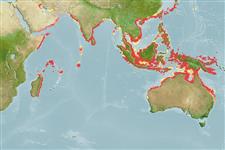>
Eupercaria/misc (Various families in series Eupercaria) >
Cepolidae (Bandfishes) > Cepolinae
Etymology: Acanthocepola: Greek, akantha = thorn + Latin, cepulla, cepa = onion.
More on author: Valenciennes.
Environment: milieu / climate zone / depth range / distribution range
Écologie
marin benthopélagique; profondeur 10 - 80 m (Ref. 127963). Tropical; 31°N - 29°S, 47°E - 155°E
Indo-West Pacific: Persian Gulf, Vietnam, Indonesia (Java to Flores and West Papua), Philippines, Papua New Guinea (Port Moresby to Milne Bay), and Australia (Queensland; Northern Territory and Western Australia).
Taille / Poids / Âge
Maturity: Lm ? range ? - ? cm
Max length : 30.0 cm TL mâle / non sexé; (Ref. 11441)
Rayons mous dorsaux (Total) : 69 - 80; Épines anales: 0 - 2; Rayons mous anaux: 70 - 84; Vertèbres: 45 - 49. This species is characterized by the following: HL 6.3-8.4 in SL; preopercle with 5 blunt spines, the longest at angle. Colouration: head and body orange-pink with double series of yellow spots (smaller than pupil) on the sides; dorsal fin yellow-orange, anal fin yellow and median fins with narrow black margins; paired fins yellow with pink rays (Ref. 127963).
Occurs in muddy habitats, usually in large colonies, each individual with its own burrow. Rises high above the substrate in schools to feed when plankton drifts over, typically in vertical posture (Ref. 48635).
Life cycle and mating behavior
Maturité | Reproduction | Frai | Œufs | Fécondité | Larves
Kailola, P.J., 1987. The fishes of Papua New Guinea: a revised and annotated checklist. Vol. II Scorpaenidae to Callionymidae. Research Bulletin No. 41, Research Section, Dept. of Fisheries and Marine Resources, Papua New Guinea. (Ref. 6192)
Statut dans la liste rouge de l'IUCN (Ref. 130435: Version 2024-1)
Menace pour l'homme
Harmless
Utilisations par l'homme
Pêcheries:
Outils
Articles particuliers
Télécharger en XML
Sources Internet
Estimates based on models
Preferred temperature (Ref.
123201): 25.6 - 29.1, mean 28.3 °C (based on 674 cells).
Phylogenetic diversity index (Ref.
82804): PD
50 = 0.5625 [Uniqueness, from 0.5 = low to 2.0 = high].
Bayesian length-weight: a=0.00339 (0.00183 - 0.00629), b=2.85 (2.67 - 3.03), in cm total length, based on LWR estimates for this species & (Sub)family-body (Ref.
93245).
Niveau trophique (Ref.
69278): 3.4 ±0.45 se; based on food items.
Résilience (Ref.
120179): Haut, temps minimum de doublement de population inférieur à 15 mois (Preliminary K or Fecundity.).
Fishing Vulnerability (Ref.
59153): Low vulnerability (20 of 100).
